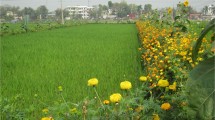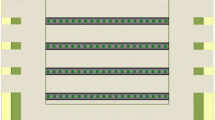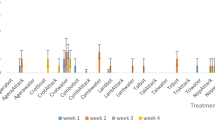Abstract
Conservation biological control avoids the need for mass releases of costly agents and the risks associated with introducing exotic agents by promoting existing natural enemies. This is done by alleviating insecticide-induced mortality and by manipulating the habitat to provide resources such as nectar, but there is a dearth of information on the relative and interactive effects of these two approaches. Here we used a large-scale factorial experiment with plots comprised of entire fields to test the effects of, and interactions between, withholding insecticides and planting borders of sesame (Sesamum indicum) on natural enemies and pests over 2 years. We used yellow sticky traps, sweeping netting and sentinel bait plants to monitor natural enemies and pests in the canopy and basal zones of the rice crop. Numbers of rice planthopper egg parasitoids and lepidopterous egg parasitoids in the rice canopy, as well as planthopper parasitism rates, were significantly greater in plots that were unsprayed and bordered by sesame, and scarcest in sprayed crops without sesame. Spraying of sesame-bordered crops gave parasitoid numbers similar to sprayed crops without sesame. Spiders in the canopy were significantly reduced in numbers by spraying, but there was no main effect of sesame borders. This study demonstrates that withholding insecticides and sowing nectar plant borders each have measurable as well as additive benefits on in-crop densities of ecosystem service providers responsible for predating and parasitising pests but the identity of the natural enemy determines the impact of these management practices.



Similar content being viewed by others
References
Altieri MA (1999) The ecological role of biodiversity in agroecosystems. Agric Ecosyst Environ 74:19–31. https://doi.org/10.1016/S0167-8809(99)00028-6
Araj S-E, Wratten SD (2015) Comparing existing weeds and commonly used insectary plants as floral resources for a parasitoid. Biol Control 81:15–20. https://doi.org/10.1016/j.biocontrol.2014.11.003
Balzan MV, Wäckers FL (2013) Flowers to selectively enhance the fitness of a host feeding parasitoid: adult feeding by Tuta absoluta and its parasitoid Necremnus artynes. Biol Control 67:21–31. https://doi.org/10.1016/j.biocontrol.2013.06.006
Bambaradeniya C, Edirisinghe J (2008) Composition, structure and dynamics of arthropod communities in a rice agro-ecosystem. Ceylon J Sci Biol Sci 37:23–48. https://doi.org/10.4038/cjsbs.v37i1.494
Barbosa P (1998) Conservation biological control. Academic, New York
Biondi A, Desneux N, Siscaro G, Zappalà L (2012) Using organic-certified rather than synthetic pesticides may not be safer for biological control agents: selectivity and side effects of 14 pesticides on the predator Orius laevigatus. Chemosphere 87:803–812. https://doi.org/10.1016/j.chemosphere.2011.12.082
Biondi A, Zappalà L, Stark JD, Desneux N (2013) Do biopesticides affect the demographic traits of a parasitoid wasp and its biocontrol services through sublethal effects? PLoS ONE 8:e76548. https://doi.org/10.1371/journal.pone.0076548
Biondi A, Zappalà L, Di Mauro A et al (2016) Can alternative host plant and prey affect phytophagy and biological control by the zoophytophagous mirid Nesidiocoris tenuis? Biocontrol 61:79–90. https://doi.org/10.1007/s10526-015-9700-5
Brennan EB (2016) Agronomy of strip intercropping broccoli with alyssum for biological control of aphids. Biol Control 97:109–119. https://doi.org/10.1016/j.biocontrol.2016.02.015
Campolo O, Malacrinò A, Laudani F et al (2016) Bees visiting flowers of Thymus longicaulis (Lamiaceae). Plant Biosyst 150:1182–1188. https://doi.org/10.1080/11263504.2015.1009190
Chailleux A, Mohl EK, Teixeira Alves M et al (2014) Natural enemy-mediated indirect interactions among prey species: potential for enhancing biocontrol services in agroecosystems. Pest Manag Sci 70:1769–1779. https://doi.org/10.1002/ps.3916
Charles JJ, Paine TD (2016) Fitness effects of food resources on the polyphagous aphid parasitoid, Aphidius colemani Viereck (Hymenoptera: Braconidae: Aphidiinae). PLoS ONE 11:e0147551. https://doi.org/10.1371/journal.pone
Chen XQ, Chen YC, Wu LB et al (2010) A survey of nectar feeding by spiders in three different habitats. Bull Insectol 63:203–208
Cheng JA (2015) Rice planthoppers in the past half century in china. In: Heong KL, Cheng JA, Escalada MM (eds) Rice planthoppers: ecology, management, socio economics and policy. Springer Netherlands, Rotterdam, pp 1–32
da Silva Camilo S, Soares MA, Leite GLD et al (2016) Do floral resources in Eucalyptus plantations affect fitness parameters of the parasitoid Palmistichus elaeisis (Hymenoptera: Eulophidae)? Phytoparasitica 44:651–659. https://doi.org/10.1007/s12600-016-0549-7
FAO (2014) FAOSTAT data. http://www.fao.org/faostat/en/
García RR, Miñarro M (2014) Role of floral resources in the conservation of pollinator communities in cider-apple orchards. Agric Ecosyst Environ 183:118–126. https://doi.org/10.1016/j.agee.2013.10.017
Géneau CE, Wäckers FL, Luka H, Daniel C et al (2012) Selective flowers to enhance biological control of cabbage pests by parasitoids. Basic Appl Ecol 13:85–93. https://doi.org/10.1016/j.baae.2011.10.005
Géneau CE, Wäckers FL, Luka H, Balmer O (2013) Effects of extrafloral and floral nectar of Centaurea cyanus on the parasitoid wasp Microplitis mediator: olfactory attractiveness and parasitization rates. Biol Control 66:16–20. https://doi.org/10.1016/j.biocontrol.2013.02.007
Gontijo LM, Beers EH, Snyder WE (2013) Flowers promote aphid suppression in apple orchards. Biol Control 66:8–15. https://doi.org/10.1016/j.biocontrol.2013.03.007
Gontijo PC, Moscardini VF, Michaud J, Carvalho GA (2014) Non-target effects of chlorantraniliprole and thiamethoxam on Chrysoperla carnea when employed as sunflower seed treatments. J Pest Sci 87:711–719. https://doi.org/10.1007/s10340-014-0611-5
Gurr GM, Liu J, Read DMY et al (2011) Parasitoids of Asian rice planthopper (Hemiptera: Delphacidae) pests and prospects for enhancing biological control by ecological engineering. Ann Appl Biol 158:149–176. https://doi.org/10.1111/j.1744-7348.2010.00455.x
Gurr GM, Read DMY, Catindig JLA et al (2012) Parasitoids of the rice leaffolder Cnaphalocrocis medinalis and prospects for enhancing biological control with nectar plants. Agric Forest Entomol 14:1–12. https://doi.org/10.1111/j.1461-9563.2011.00550.x
Gurr GM, Lu ZX, Zheng XS et al (2016) Multi-country evidence that crop diversification promotes ecological intensification of agriculture. Nat Plants 2:16014. https://doi.org/10.1038/nplants.2016.14
Gurr GM, Wratten SD, Landis DA, You MS (2017) Habitat management to suppress pest populations: progress and prospects. Annu Rev Entomol 62:91–109. https://doi.org/10.1146/annurev-ento-031616-035050
He JH (2004) Hymenoptera insect Fauna of Zhejiang. Science Press, Beijing, XLIII plates, (in Chinese)
He JH, Pang XF (1986) Natural enemies of rice pests. Shanghai Press of Science and Technology, Shanghai (in Chinese)
He JH, Chen XX, Ma Y (1996) Fauna sinica insects, volume 51. Hymenoptera: Ichneumonidae, vol 51. Science Press, Beijing (in Chinese)
Heimpel GE, Mills NJ (2017) Biological control: ecology and applications. Cambridge University Press, Cambridge
Heong KL, Wong L, Delos Reyes J (2015) Addressing planthopper threats to Asian rice farming and food security: fixing insecticide misuse. In: Heong KL, Cheng JA, Escalada MM (eds) Rice planthoppers: ecology, management, socio economics and policy. Springer Netherlands, Rotterdam, pp 65–76
Horgan FG, Ramal AF, Villegas JM et al (2017) Effects of bund crops and insecticide treatments on arthropod diversity and herbivore regulation in tropical rice fields. J Appl Entomol. https://doi.org/10.1111/jen.12383
Hunan Agricultural Academy and Institute (HAAI) (1978) Monograph of insect pests and their natural enemies of rice. Plant Protection Department, Changsha (in Chinese)
Irvin NA, Pinckard TR, Perring TM, Hoddle MS (2014) Evaluating the potential of buckwheat and cahaba vetch as nectar producing cover crops for enhancing biological control of Homalodisca vitripennis in California vineyards. Biol Control 76:10–18. https://doi.org/10.1016/j.biocontrol.2014.04.006
Irvin NA, Bistline-East A, Hoddle MS (2016) The effect of an irrigated buckwheat cover crop on grape vine productivity, and beneficial insect and grape pest abundance in southern California. Biol Control 93:72–83. https://doi.org/10.1016/j.biocontrol.2015.11.009
Janković M, Plećaš M, Sandić D et al (2016) Functional role of different habitat types at local and landscape scales for aphids and their natural enemies. J Pest Sci. https://doi.org/10.1007/s10340-016-0744-9
Landis DA, Wratten SD, Gurr GM (2000) Habitat management to conserve natural enemies of arthropod pests in agriculture. Annu Rev Entomol 45:175–201. https://doi.org/10.1146/annurev.ento.45.1.175
Lavandero B, Wratten SD, Didham RK, Gurr GM (2006) Increasing floral diversity for selective enhancement of biological control agents: A double-edged sward? Basic Appl Ecol 7:236–243. https://doi.org/10.1016/j.baae.2005.09.004
Lee J, Heimpel G (2008) Effect of floral nectar, water, and feeding frequency on Cotesia glomerata longevity. Biocontrol 53:289–294. https://doi.org/10.1007/s10526-007-9070-8
Lee JC, Menalled FD, Landis DA (2001) Refuge habitats modify impact of insecticide disturbance on carabid beetle communities. J Appl Ecol 38:472–483. https://doi.org/10.1046/j.1365-2664.2001.00602.x
Lester PJ, Thistlewood HMA, Harmsen R (1998) The effects of refuge size and number on acarine predator–prey dynamics in a pesticide-disturbed apple orchard. J Appl Ecol 35:323–331. https://doi.org/10.1046/j.1365-2664.1998.00304.x
Liu TX, Zhang YM, Peng LN et al (2012) Risk assessment of selected insecticides on Tamarixia triozae (Hymenoptera: Eulophidae), a parasitoid of Bactericera cockerelli (Hemiptera: Trizoidae). J Econ Entomol 105:490–496. https://doi.org/10.1603/EC11295
Lou YG, Zhang GR, Zhang WQ et al (2013) Biological control of rice insect pests in China. Biol Control 67:8–20. https://doi.org/10.1016/j.biocontrol.2013.06.011
Lu ZX, Villareal S, Yu XP, et al (2006) Biodiversity and dynamics of planthoppers and their natural enemies in rice fields with different nitrogen regimes. Rice Sci 13:218–226. http://www.ricesci.cn; www.ricescience.org
Lu ZX, Zhu PY, Gurr GM et al (2014) Mechanisms for flowering plants to benefit arthropod natural enemies of insect pests: prospects for enhanced use in agriculture. Insect Sci 21:1–12. https://doi.org/10.1111/1744-7917.12000
Macfadyen S, Davies AP, Zalucki MP (2015) Assessing the impact of arthropod natural enemies on crop pests at the field scale. Insect Sci 22:20–34. https://doi.org/10.1111/1744-7917.12174
Nave A, Gonçalves F, Crespí A et al (2016) Evaluation of native plant flower characteristics for conservation biological control of Prays oleae. B Entomol Res 106:249–257. https://doi.org/10.1017/S0007485315001091
Nyffeler M, Birkhofer K (2017) An estimated 400–800 million tons of prey are annually killed by the global spider community. Sci Nat 104:30. https://doi.org/10.1007/s00114-017-1440-1
Ohnesorg WJ, Johnson KD, O’Neal ME (2009) Impact of reduced-risk insecticides on soybean aphid and associated natural enemies. J Econ Entomol 102:1816–1826. https://doi.org/10.1603/029.102.0512
Orr D (2009) Biological control and integrated pest management. In: Peshin R, Dhawan AK (eds) Integrated pest management: innovation-development process. Springer Netherlands, Rotterdam, pp 207–239
Pozzebon A, Ahmad S, Tirello P et al (2014) Does pollen availability mitigate the impact of pesticides on generalist predatory mites? Biocontrol 59:585–596. https://doi.org/10.1007/s10526-014-9598-3
Pumariño L, Alomar O, Lundgren JG (2012) Effects of floral and extrafloral resource diversity on the fitness of an omnivorous bug, Orius insidiosus. Entomol Exp Appl 145:181–190. https://doi.org/10.1111/eea.12002
R Core Team (2017) R: a language and environment for statistical computing. R Foundation for Statistical Computing, Vienna, Austria. https://www.R-project.org/
Robinson KA, Jonsson M, Wratten SD et al (2008) Implications of floral resources for predation by an omnivorous lacewing. Basic Appl Ecol 9:172–181. https://doi.org/10.1016/j.baae.2007.01.002
Saeed R, Razaq M, Hardy ICW (2015) The importance of alternative host plants as reservoirs of the cotton leaf hopper, Amrasca devastans, and its natural enemies. J Pest Sci 88:517–531. https://doi.org/10.1007/s10340-014-0638-7
Settele J, Biesmeijer J, Bommarco R (2008) Switch to ecological engineering would aid independence. Nature 456:570. https://doi.org/10.1038/456570a
Settele J, Spangenberg JH, Kong LH et al (2016) Agricultural landscapes and ecosystem services in South-East Asia—the LEGATO-project. Basic Appl Ecol 16:661–664. https://doi.org/10.1016/j.baae.2015.10.003
Settle WH, Ariawan H, Astuti ET et al (1996) Managing tropical rice pests through conservation of generalist natural enemies and alternative prey. Ecology 77:1975–1988. https://doi.org/10.2307/2265694
Smith IM, Hoffmann AA, Thomson LJ (2015) Ground cover and floral resources in shelterbelts increase the abundance of beneficial hymenopteran families. Agr Forest Entomol 17:120–128. https://doi.org/10.1111/afe.12086
Tavares J, Wang K-H, Hooks CRR (2015) An evaluation of insectary plants for management of insect pests in a hydroponic cropping system. Biol Control 91:1–9. https://doi.org/10.1016/j.biocontrol.2015.07.004
van Driesche RG, Bellows TS (1996) Biological control. Springer, Chapman and Hall, New York
van Rijn PCJ, Tanigoshi LK (1999) Pollen as food for the predatory mites Iphiseius degenerans and Neoseiulus cucumeris (Acari: Phytoseiidae): dietary range and life history. Exp Appl Acarol 23:785–802. https://doi.org/10.1023/A:1006227704122
van Rijn PCJ, van Houten YM, Sabelis MW (2002) How plants benefit from providing food to predators even when it is also edible to herbivores. Ecology 83:2664–2679. https://doi.org/10.2307/3072005
van Rijn PCJ, Kooijman J, Wäckers FL (2006) The impact of floral resources on syrphid performance and cabbage aphid biological control. IOBC WPRS Bull 29:149–152
Wang XQ, Wang GH, Zhu ZR et al (2016) Spider (Araneae) predations on white-backed planthopper Sogatella furcifera in subtropical rice ecosystems, China. Pest Manag Sci 73:1277–1286. https://doi.org/10.1002/ps.4459
Winkler K, Wäckers FL, Bukovinszkine-Kiss G, van Lenteren JC (2006) Sugar resources are vital for Diadegma semiclausum fecundity under field conditions. Basic Appl Ecol 7:133–140. https://doi.org/10.1016/j.baae.2005.06.001
Yu XP, Barrion AT, Lu ZX (2001) A taxonomic investigation on egg parasitoid, Anagrus of rice planthopper in Zhejiang Province. Chin Rice Res Newslett 9:8–9
Zhang ZQ, Zhou C, Xu YY et al (2016) Effects of intercropping tea with aromatic plants on population dynamics of arthropods in Chinese tea plantations. J Pest Sci 90:1–11. https://doi.org/10.1007/s10340-016-0783-2
Zhao J, Guo X, Tan X et al (2016) Using Calendula officinalis as a floral resource to enhance aphid and thrips suppression by the flower bug Orius sauteri (Hemiptera: Anthocoridae). Pest Manag Sci. https://doi.org/10.1002/ps.4474
Zhu PY, Gurr GM, Lu ZX et al (2013) Laboratory screening supports the selection of sesame (Sesamum indicum) to enhance Anagrus spp. parasitoids (Hymenoptera: Mymaridae) of rice planthoppers. Biol Control 64:83–89. https://doi.org/10.1016/j.biocontrol.2012.09.014
Zhu PY, Lu ZX, Heong KL et al (2014) Selection of nectar plants for use in ecological engineering to promote biological control of rice pests by the predatory bug, Cyrtorhinus lividipennis, (Heteroptera: Miridae). PLoS ONE 9:e108669. https://doi.org/10.1371/journal.pone.0108669
Zhu PY, Wang GW, Zheng XS et al (2015) Selective enhancement of parasitoids of rice Lepidoptera pests by sesame (Sesamum indicum) flowers. Biocontrol 60:157–167. https://doi.org/10.1007/s10526-014-9628-1
Acknowledgements
Assistance with arthropod sorting and taxonomy was provided by Miss Sylvia Villareal and Josie Lynn Catindig from International Rice Research Institute and Mr Ding Luo, Miss Biqing Dong, Miss Xiaochan He and Jingjing He from Zhejiang Academy of Agricultural Sciences China. We wish to thank host growers (Tiande Dai) for access to his properties and the field work assistance.
Funding
This study was supported by Zhejiang Provincial Key Research and Development Plan (Grant No. 2015C02014) and State Key Laboratory Breeding Base for Zhejiang Sustainable Pest Control (Grant No. 2010DS700124-ZZ1601).
Author information
Authors and Affiliations
Corresponding author
Ethics declarations
Conflict of interest
All authors declare that they have no conflict of interest.
Human and animal rights statement
This article does not contain any studies with human participants or animals (other than insects) performed by any of the authors.
Additional information
Communicated by B. Lavandero.
Electronic supplementary material
Below is the link to the electronic supplementary material.
Rights and permissions
About this article
Cite this article
Zhu, P., Zheng, X., Zhang, F. et al. Quantifying the respective and additive effects of nectar plant crop borders and withholding insecticides on biological control of pests in subtropical rice. J Pest Sci 91, 575–584 (2018). https://doi.org/10.1007/s10340-017-0946-9
Received:
Revised:
Accepted:
Published:
Issue Date:
DOI: https://doi.org/10.1007/s10340-017-0946-9




